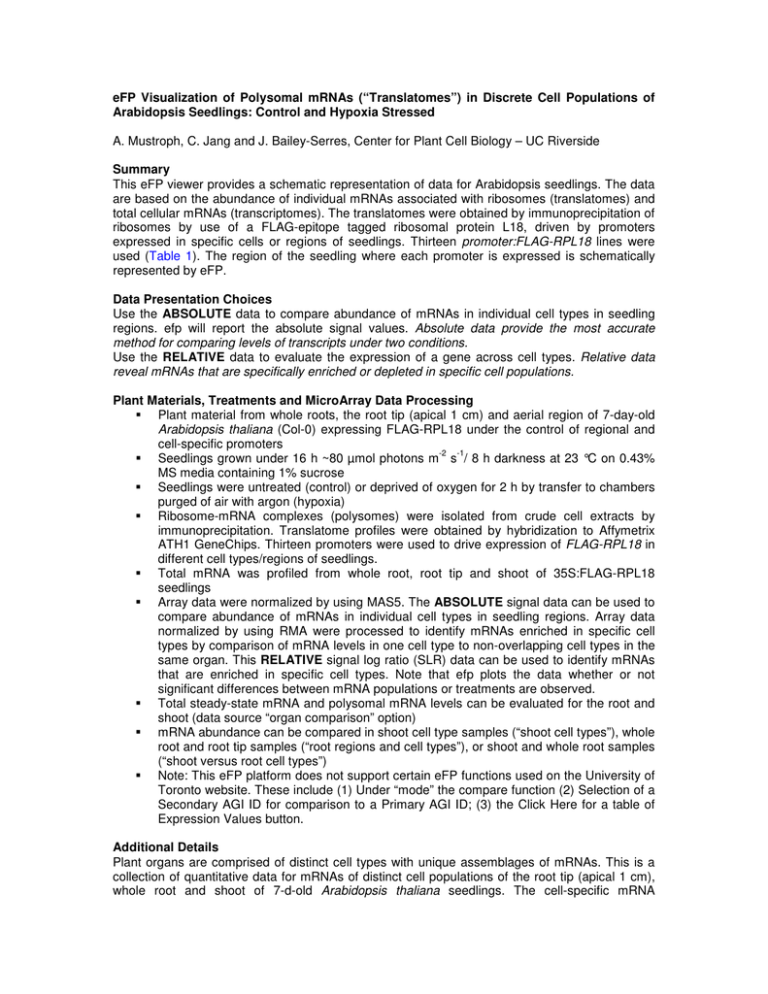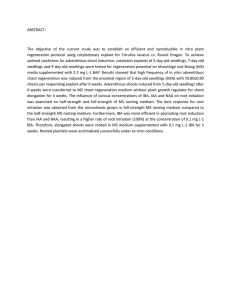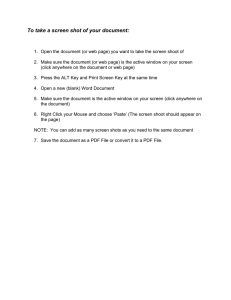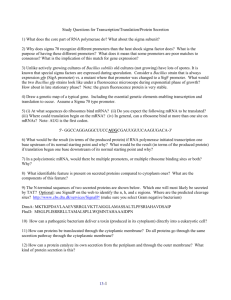Summary - Cell Type Specific Arabidopsis eFP Browser
advertisement

eFP Visualization of Polysomal mRNAs (“Translatomes”) in Discrete Cell Populations of Arabidopsis Seedlings: Control and Hypoxia Stressed A. Mustroph, C. Jang and J. Bailey-Serres, Center for Plant Cell Biology – UC Riverside Summary This eFP viewer provides a schematic representation of data for Arabidopsis seedlings. The data are based on the abundance of individual mRNAs associated with ribosomes (translatomes) and total cellular mRNAs (transcriptomes). The translatomes were obtained by immunoprecipitation of ribosomes by use of a FLAG-epitope tagged ribosomal protein L18, driven by promoters expressed in specific cells or regions of seedlings. Thirteen promoter:FLAG-RPL18 lines were used (Table 1). The region of the seedling where each promoter is expressed is schematically represented by eFP. Data Presentation Choices Use the ABSOLUTE data to compare abundance of mRNAs in individual cell types in seedling regions. efp will report the absolute signal values. Absolute data provide the most accurate method for comparing levels of transcripts under two conditions. Use the RELATIVE data to evaluate the expression of a gene across cell types. Relative data reveal mRNAs that are specifically enriched or depleted in specific cell populations. Plant Materials, Treatments and MicroArray Data Processing Plant material from whole roots, the root tip (apical 1 cm) and aerial region of 7-day-old Arabidopsis thaliana (Col-0) expressing FLAG-RPL18 under the control of regional and cell-specific promoters -2 -1 Seedlings grown under 16 h ~80 µmol photons m s / 8 h darkness at 23 °C on 0.43% MS media containing 1% sucrose Seedlings were untreated (control) or deprived of oxygen for 2 h by transfer to chambers purged of air with argon (hypoxia) Ribosome-mRNA complexes (polysomes) were isolated from crude cell extracts by immunoprecipitation. Translatome profiles were obtained by hybridization to Affymetrix ATH1 GeneChips. Thirteen promoters were used to drive expression of FLAG-RPL18 in different cell types/regions of seedlings. Total mRNA was profiled from whole root, root tip and shoot of 35S:FLAG-RPL18 seedlings Array data were normalized by using MAS5. The ABSOLUTE signal data can be used to compare abundance of mRNAs in individual cell types in seedling regions. Array data normalized by using RMA were processed to identify mRNAs enriched in specific cell types by comparison of mRNA levels in one cell type to non-overlapping cell types in the same organ. This RELATIVE signal log ratio (SLR) data can be used to identify mRNAs that are enriched in specific cell types. Note that efp plots the data whether or not significant differences between mRNA populations or treatments are observed. Total steady-state mRNA and polysomal mRNA levels can be evaluated for the root and shoot (data source “organ comparison” option) mRNA abundance can be compared in shoot cell type samples (“shoot cell types”), whole root and root tip samples (“root regions and cell types”), or shoot and whole root samples (“shoot versus root cell types”) Note: This eFP platform does not support certain eFP functions used on the University of Toronto website. These include (1) Under “mode” the compare function (2) Selection of a Secondary AGI ID for comparison to a Primary AGI ID; (3) the Click Here for a table of Expression Values button. Additional Details Plant organs are comprised of distinct cell types with unique assemblages of mRNAs. This is a collection of quantitative data for mRNAs of distinct cell populations of the root tip (apical 1 cm), whole root and shoot of 7-d-old Arabidopsis thaliana seedlings. The cell-specific mRNA populations are those present in ribosome-mRNA complexes. This sub-population of mRNAs was obtained by establishing a collection of Arabidopsis lines that express a FLAG-epitope tagged ribosomal protein L18 (RPL18) directed by promoters expressed in specific cell types and regions. Thirteen different promoter:FLAG-RPL18 lines were used (see Table 1). Expression of these promoters in specific cell types and regions was confirmed using promoter:FLAG-GFPRPL18 lines (Figure 1). The immunopurification of ribosome-mRNA complexes of specific cell types/regions was accomplished by described methods (Zanetti et al., 2005; Branco-Price et al., 2008). The dataset includes samples from cell types/regions from seedlings grown under control conditions and cell types/regions of seedlings exposed to low oxygen stress (hypoxia) for 2 h (Branco-Price et al., 2008). Data normalization CEL files from the Affymetrix Chips were processed by use of the R program (http://cran.at.rproject.org/) and Bioconductor packages (http://www.bioconductor.org/). The Robust Multi-chip Average (RMA) normalization was performed using the default settings of the corresponding R function (Irizarry et al., 2003). Independently, the CEL files were normalized by the MAS5 normalization method for the usage in the fuzzy-k-means clustering. To estimate the amount of expressed mRNA, the present call information of the non-parametric Wilcoxon signed rank test was computed with the Affy package (PMA values, Liu et al., 2002). Hybridization data from at least two biological replicates were generated for each promoter:FLAG-RPL18 line, tissue sample and treatment. Probes that did not have present calls in all replicates of at least one sample set were excluded. Genes not represented on the GeneChip or not included in the set of “present” probe pair sets do not provide data when requested with the efp site. Absolute Signal Value Data The mean of normalized MAS5 data for all replicates is shown. The normalization establishes equal signal intensity across the array samples, so that the signal of an individual gene can be compared between samples. No further modifications of the data were made, so that a direct comparison of values across cell types, organs and treatment conditions is possible. However, a strong difference either after stress treatment or between organs can mask cell-type specific variations (see Figure 2 as an example). Therefore, these values are most informative for the evaluation of stress responsive and organ specific genes. These data can be obtained for individual genes by selecting “Absolute” under the Mode menu. Relative Signal Log Ratio Data Analysis of differentially expressed genes (DEGs) was performed with the LIMMA package using the RMA normalized expression values (Smyth 2004). To identify mRNAs enriched in specific cell types, the following systematic pairwise comparisons were performed: immunopurified polysomal RNA of control or hypoxia stressed samples were compared to all other non-overlapping cell types in the same organ and under the same treatment conditions. The complete list of pairwise comparisons is provided in Table S5c of Mustroph et al., manuscript submitted. The mean of the signal-log-ratios of utilized comparisons for each cell type were calculated and is shown here. Data are relative to all cell types of a single organ and treatment condition, but do not show general expression changes due to the stress. Therefore, these values are best to evaluate celltype specific differences. These data can be obtained for individual genes by selecting “Relative” under the Mode menu. References 1. Branco-Price C, Kaiser KA, Jang CJ, Larive CK, Bailey-Serres J (2008) Selective mRNA translation coordinates energetic and metabolic adjustments to cellular oxygen deprivation and reoxygenation in Arabidopsis thaliana. Plant J. 56(5), 743-755. 2. Irizarry RA, Bolstad BM, Collin F, Cope LM, Hobbs B, Speed TP (2003) Summaries of Affymetrix GeneChip probe level data. Nucleic Acids Res. 31(4), e15. 3. Liu, W. M, Mei, R, Di, X, Ryder, T. B, Hubbell, E, Dee, S, Webster, T. A, Harrington, C. A, Ho, M. H, Baid, J, Smeekens, S. P. (2002) Analysis of high density expression microarrays with signed-rank call algorithms, Bioinformatics 18(12), 1593-1599. 4. Mustroph A, Zanetti ME, Jang CJ, Holtan H, Repetti PR, Galbraith DW, Girke T, BaileySerres J. Profiling translatomes of discrete cell populations resolves altered cellular priorities during hypoxia in Arabidopsis. (submitted) 5. Smyth GK (2004). Linear models and empirical Bayes methods for assessing differential expression in microarray experiments. Statistical Applications in Genetics and Molecular Biology, 3, No. 1, Article 3 6. Zanetti ME, Chang I-F, Gong F-C, Galbraith DW, Bailey-Serres J (2005) Immuno-affinity purification of polyribosomal complexes of Arabidopsis for global analysis of gene expression. Plant Physiol 138, 624-635 Table 1: Summary of 13 promoter:FLAG-RPL18 lines established in Arabidopsis thaliana (Col-0) for the immunopurification of mRNA-ribosome complexes (translatomes) from specific regions/cell types of seedlings. Promoter Abbre-viation Target Cell Population p35S Near constitutive pRPL11C Root proliferating cells pSCR Root endodermis, quiescent center SCARECROW (pSCR) At3g54220 pSHR Root vasculature SHORTROOT (pSHR) At4g37650 pWOL Root vasculature WOODENLEG (pWOL) At2g01830 Root and shoot phloem companion cells Root phloem companion cells, shoot bundle sheath Root atrichoblast epidermis, 1 shoot trichomes Root cortex meristematic zone Root cortex elongation and maturation zone Sucrose transporter2 (pSUC2) Sulfate transporter (pSULTR2;2) [ pSUC2 pSultr2-2 pGL2 pCO2 pPEP pRBCS Shoot photosynthetic Promoter Cauliflower mosaic virus 35S (p35S) [ Ribosomal protein L11C (pRPL11C) AGI NA At4g18730 At1g22710 At1g77990 GLABRA2 (pGL2) At1g79840 Cortex specific transcript (pCO2) [ At1g62500 Endopeptidase (pPEP) At1g09750 Rubisco small subunit (pRBCS1A) Cuticular wax gene (pCER5) At1g67090 Cotyledon and leaf At1g51500 epidermis Cotyledon and leaf guard + pKAT1 K channel (pKAT1) At5g46240 cells 1 pGL2 was expressed in the targeted cell type as well as in the phloem companion cells. pCER5 Figure 1 Figure 1: Cell-type specific promoters used in this study. Individual promoters were used to drive the production of FLAG-GFP-RPL18 in transgenic Arabidopsis seedlings (Table 1). Representative images demonstrate the specificity of promoter activity in 7-day-old seedlings of T2 transgenics. Green = GFP fluorescence, red = chlorophyll in shoots, Propidium iodide staining in roots. QC = quiescent center; LR = lateral root primordia. Scale bar = 50 µm. Absolute (MAS5.0 values) A Relative (SLR of RMA values) B Figure 2: Example of a gene with cell-specific AND responsive to the stress. SUCROSE SYNTHASE 1 (At5g20830) is enriched in phloem companion cells (pSUC2 mRNA population) under control conditions, and induced by hypoxic stress. A: The absolute values show the gene is stress-responsive, but the SUC2-specific enrichment is not clearly visible. B: The relative values show distinctions in cell-specific expression.





